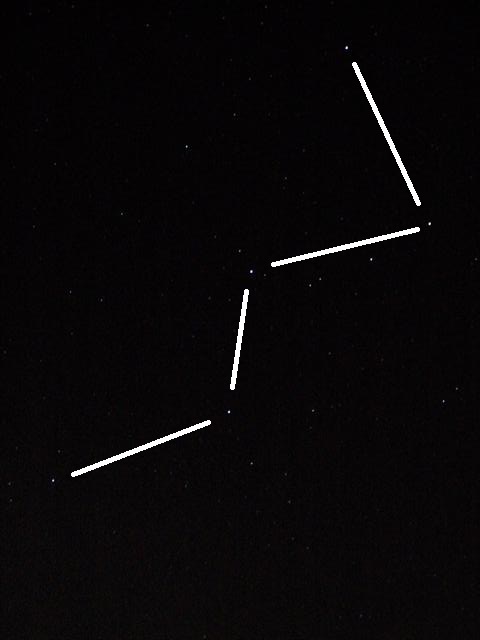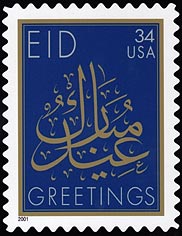The Milky Way
On that quiet evening, with no wind or gentle lapping of waves along the lake shore, only occasional crackling from the embers of our dying fire disturbed the night. Above, a billion points of light sparkled against black velvet sky. With hushed voices, we shared what we knew of planets and stars; a few we could even find and point out. We found the constellations revolving around Polaris, the North Star: The Big and Little Dippers, Cepheus, Cassiopeia, and Draco. In another part of the sky there was Orion, the mighty hunter, and the glowing, hazy, stream of the Milky Way. Someone saw the streak of a meteor. A steadily moving light must be an airplane - or was it a satellite? Hours passed and no one cared; tranquility settled upon us.
The Big Dipper (Ursa Major)
 Long ago, when people lived close to the land and knew it much better than we do, they knew the night sky. Without glaring lights from cities and traveling vehicles, the moon and brilliant stars were hard to ignore. With small, crowded homes, people gathered outdoors on temperate evenings to visit and tell stories. With minds uncluttered by our modern technological distractions, they would gaze at, study, and discuss the heavens. Their lives revolved around the seasons and the stars helped to indicate those. If they were travelers, day or night, the sky helped them plot their course.
Long ago, when people lived close to the land and knew it much better than we do, they knew the night sky. Without glaring lights from cities and traveling vehicles, the moon and brilliant stars were hard to ignore. With small, crowded homes, people gathered outdoors on temperate evenings to visit and tell stories. With minds uncluttered by our modern technological distractions, they would gaze at, study, and discuss the heavens. Their lives revolved around the seasons and the stars helped to indicate those. If they were travelers, day or night, the sky helped them plot their course.
 Long ago, when people lived close to the land and knew it much better than we do, they knew the night sky. Without glaring lights from cities and traveling vehicles, the moon and brilliant stars were hard to ignore. With small, crowded homes, people gathered outdoors on temperate evenings to visit and tell stories. With minds uncluttered by our modern technological distractions, they would gaze at, study, and discuss the heavens. Their lives revolved around the seasons and the stars helped to indicate those. If they were travelers, day or night, the sky helped them plot their course.
Long ago, when people lived close to the land and knew it much better than we do, they knew the night sky. Without glaring lights from cities and traveling vehicles, the moon and brilliant stars were hard to ignore. With small, crowded homes, people gathered outdoors on temperate evenings to visit and tell stories. With minds uncluttered by our modern technological distractions, they would gaze at, study, and discuss the heavens. Their lives revolved around the seasons and the stars helped to indicate those. If they were travelers, day or night, the sky helped them plot their course.Magi originated from a caste of Zoroastrian priests in ancient Persia, which is now known as Iran. During Roman times they were recognized as physician-astrologers who healed the sick, interpreted dreams, and cast horoscopes. Considered wise men who were truly knowledgeable, they were well known for practicing astrology. Although generally frowned upon today, in those days astronomy and astrology were closely related and practiced together. Magi charted the heavens, interpreted the signs, and studied ancient manuscripts from around the world. Mighty rulers of the day typically consulted with and relied upon the wisdom of these men. Indeed, King Herod did just that.
 Not much is known about the Magi who followed the star to find Jesus. We do not know where they came from or how many there were. Probably they came from Mesopotamia, Parthia, Syria, or Persia, but no one knows for sure. Tradition says there were 3 wise men because of their gifts of gold, frankincense, and myrrh.
Not much is known about the Magi who followed the star to find Jesus. We do not know where they came from or how many there were. Probably they came from Mesopotamia, Parthia, Syria, or Persia, but no one knows for sure. Tradition says there were 3 wise men because of their gifts of gold, frankincense, and myrrh.
 And the mysterious star? Some believe God created one special star for one special event. Others believe it was a singular super nova, exploding light-years away. Perhaps it was Jupiter, Saturn, or both arriving together on their orbits extra-close to earth. There are those who believe the star appeared only as a shape on a carefully-plotted astrological chart of the day. Whatever the case, it was an extraordinarily rare and impacting event that lured the Magi thousands of miles to see the king of the Jews.
And the mysterious star? Some believe God created one special star for one special event. Others believe it was a singular super nova, exploding light-years away. Perhaps it was Jupiter, Saturn, or both arriving together on their orbits extra-close to earth. There are those who believe the star appeared only as a shape on a carefully-plotted astrological chart of the day. Whatever the case, it was an extraordinarily rare and impacting event that lured the Magi thousands of miles to see the king of the Jews.
Cassiopeia
 The “how” does not matter to me so much as the “what” and “why”. Gathered as we were at our family cabin, we were stunningly aware that there was more we didn’t know, than what we did, about the heavens that summer. Mostly, we were simply awed and humbled by a vast and nearly incomprehensible universe flung so grandly light-years beyond us. Only God could do that, and if He did that - He can do anything.
The “how” does not matter to me so much as the “what” and “why”. Gathered as we were at our family cabin, we were stunningly aware that there was more we didn’t know, than what we did, about the heavens that summer. Mostly, we were simply awed and humbled by a vast and nearly incomprehensible universe flung so grandly light-years beyond us. Only God could do that, and if He did that - He can do anything.
 Not much is known about the Magi who followed the star to find Jesus. We do not know where they came from or how many there were. Probably they came from Mesopotamia, Parthia, Syria, or Persia, but no one knows for sure. Tradition says there were 3 wise men because of their gifts of gold, frankincense, and myrrh.
Not much is known about the Magi who followed the star to find Jesus. We do not know where they came from or how many there were. Probably they came from Mesopotamia, Parthia, Syria, or Persia, but no one knows for sure. Tradition says there were 3 wise men because of their gifts of gold, frankincense, and myrrh.  And the mysterious star? Some believe God created one special star for one special event. Others believe it was a singular super nova, exploding light-years away. Perhaps it was Jupiter, Saturn, or both arriving together on their orbits extra-close to earth. There are those who believe the star appeared only as a shape on a carefully-plotted astrological chart of the day. Whatever the case, it was an extraordinarily rare and impacting event that lured the Magi thousands of miles to see the king of the Jews.
And the mysterious star? Some believe God created one special star for one special event. Others believe it was a singular super nova, exploding light-years away. Perhaps it was Jupiter, Saturn, or both arriving together on their orbits extra-close to earth. There are those who believe the star appeared only as a shape on a carefully-plotted astrological chart of the day. Whatever the case, it was an extraordinarily rare and impacting event that lured the Magi thousands of miles to see the king of the Jews. Cassiopeia

 The “how” does not matter to me so much as the “what” and “why”. Gathered as we were at our family cabin, we were stunningly aware that there was more we didn’t know, than what we did, about the heavens that summer. Mostly, we were simply awed and humbled by a vast and nearly incomprehensible universe flung so grandly light-years beyond us. Only God could do that, and if He did that - He can do anything.
The “how” does not matter to me so much as the “what” and “why”. Gathered as we were at our family cabin, we were stunningly aware that there was more we didn’t know, than what we did, about the heavens that summer. Mostly, we were simply awed and humbled by a vast and nearly incomprehensible universe flung so grandly light-years beyond us. Only God could do that, and if He did that - He can do anything.After Jesus was born in Bethlehem in Judea, during the time of King Herod, Magi from the east came to Jerusalem and asked, “Where is the one who has been born king of the Jews? We saw his star in the east and have come to worship him.”
Then Herod called the Magi secretly and found out from them the exact time the star had appeared. He sent them to Bethlehem and said, “Go and make a careful search for the child. As soon as you find him, report to me, so that I too may go and worship him.”
Matthew 2:1,2, 7-8
Constellation picture files from Wikimedia Commons
Milky Way by Serge Brunier
Big Dipper by Gh5046
Orion by Mouser
Cassiopeia by Randal J. Ferret
*This nearly life-sized outdoor nativity scene was produced over a four year period of time with church youth at a summer family camp. I designed and sketched each figure, the kids enlarged and traced them onto exterior plywood, cut them out, primed and painted them. I did final painting in the fall. Many hours of effort went into creating this, which is displayed each year in front of our church.














































